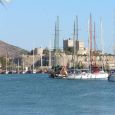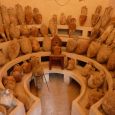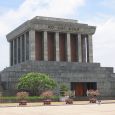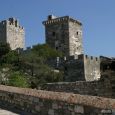Bodrum
Advertisement
By Air
Bodrum Airport, located 36kms northeast of town, offers flights to and from most major European destinations, with frequent services to London and Luton international airports in the UK. Flight time from London to Bodrum is 3 hours 30 minutes. A spacious new international terminal was completed in 2000. The old terminal, now reserved for domestic flights, is one kilometre away, a 15-minute walk across a grassy field.
Facilities at the airport include a limited number of shops, cafs and bars. A phone shop is open 24 hours, convenient for purchasing telephone cards if your mobile phone doesnt work straight away. The North Shield Pub is open from 09:00 until 23:00, and serves traditional English pub fare.
A widened highway between Bodrum and the airport has cut transfer time by car to only 30 minutes. HAVAS provides a bus service from the airport to the centre of Bodrum. Airport taxis are plentiful, and charge fixed rates to many destinations. A rate board posted at the terminals displays the fares to 44 cities and towns in the region.
By Ferry
The Bodrum to Datca passenger and vehicle ferry service only runs during the summer season, from May until October. Its a daily service, taking 3 hours.
A hydrofoil ferry boat departs every day except Sundays around 17:00 from Kos in Greece to Bodrum. As with most of the seasonal domestic ferry services, the dates when the service begins and ends depends on demand, often not starting until June and finishing in September.
By Bus
A number of intercity bus companies operate services to Bodrum from major cities in Turkey such as Istanbul, Ankara, Izmir, Adana, Bursa and Konya. From Istanbul to Bodrum, the journey takes 12 hours, while from Ankara, the trip can be done in 10 hours. Many of the bus services are night buses, which arrive in town in the early morning. If youre hopping along the coast, standard minibuses run regularly from all points east or west.
Within the city, minibuses (known as dolmus in Turkish) offer connections to all villages and beaches. They depart from the central bus station (otogar in Turkish), which is located on Cevat Sakir Street. You can get on at the bus station or anywhere along a route by signalling the driver to stop for you. Likewise, you can get off at any convenient point anywhere along the route; just tell the driver.
By Car
Bodrum is located 840kms from Istanbul and can be reached by car in around 12 hours. In Turkey, traffic drives on the right and road signs are international. Where there are no posted speed limits, the legal speed limit is 40kms per hour in towns and villages; and 90kms per hour on the highways. Seat belts are compulsory and drivers must not use mobile phones while driving.
Bodrum Kalesi
Bodrum's principal sight, the Castle of St Peter, now known as Bodrum Kalesi, with its tall, well-preserved towers, was built by the Knights Hospitallers of St John between 1402 and 1437 on the site of the islet of Zephyrion, now joined to the mainland. It replaced an earlier castle built on the site of the first Greek settlement. The Turks erected other buildings within the precincts of the castle, and in the Late Ottoman period it was used as a place of exile. As with the defenses of Rhodes, knights of the various nationalities in the Order were entrusted with the defense of particular sections of the walls. The English Tower, having a sculpted lion on its west wall, is also known as the Lion Tower
Museum
The various buildings within the castle in Bodrum, together with the upper and lower wards, have been turned into a very interesting museum, the arrangement of which has not yet been completed.
From the mosque (1723) in the Harbor Square a ramp leads up into the outer ward, on the far side of which is an arched gateway giving access to the lower ward (ticket office). Here there is a Gothic chapel, built by Spanish knights in 1520 and later converted into a mosque. It contains Bronze Age material and the only fragment of a frieze from the Mausoleion still preserved in Bodrum. In the towers of the castle are collections of objects of various kinds and different periods (architectural fragments, sculptures, jewelry, coins, etc.) and other items are displayed in the open.
Mausoleion
The ancient city of Halikarnassos was traversed by a main street running from its east end to the fine Myndos Gate (Gümüsli Kapi) with its tower at the west end. In this street, in the center of the town, stood the famous Mausoleion or Mausoleum, which from the time of Augustus became a general term for a large tomb. Its architect was Pytheos. Under the direction of Satyros the rectangular tower-like structure, 46m/150ft high, was decorated with magnificent friezes by the most celebrated Greek sculptors of the day. Erected in 351 B.C. it survived in good condition until the 12th century A.D. Thereafter it may have been damaged by earthquakes and was then gradually pulled down, being finally destroyed in 1552 when the remaining stone was used to strengthen the castle against Ottoman attack. Dressed stones from the Mausoleum can be seen in the castle, the town walls, and at the bottom of an old well in the town. A reconstruction of the monument is planned.
The first reliefs recovered from the Mausoleum were taken to London in 1846; in 1863 C. T. (later Sir Charles) Newton positively identified the site of the monument and removed much sculpture from the Mausoleion and the castle to the British Museum. Excavations were carried out by Danish archeologists in 1966/67.
St Peters Castle
The castle protrudes out into the centre of Bodrums two harbours. During the reign of Mausolos, there was most likely a temple in honour of Apollo on the site, in addition to a palace fortress. The kingdom of Pergamum inherited the land structure before it passed to Rome and wound up in the hands of the Turks. Western sources say that the Knights Hospitalers of St John seized the settlement Seluk from Turkish hands to give refuge to Christians and increase their power over the west coast of Asia during the Crusades.
Turkish references state that Sultan Celebi Mehmet gave permission to the Knights Hospitalers to construct an outpost. Construction of the castle began in 1402 and once finished, it turned into a symbol of the unity of Christian Europe against the Ottoman infidels. The naming of the castle towers represents the participation of the different European nations, as do the plaques, inscriptions, armour and other artefacts.
December - March





